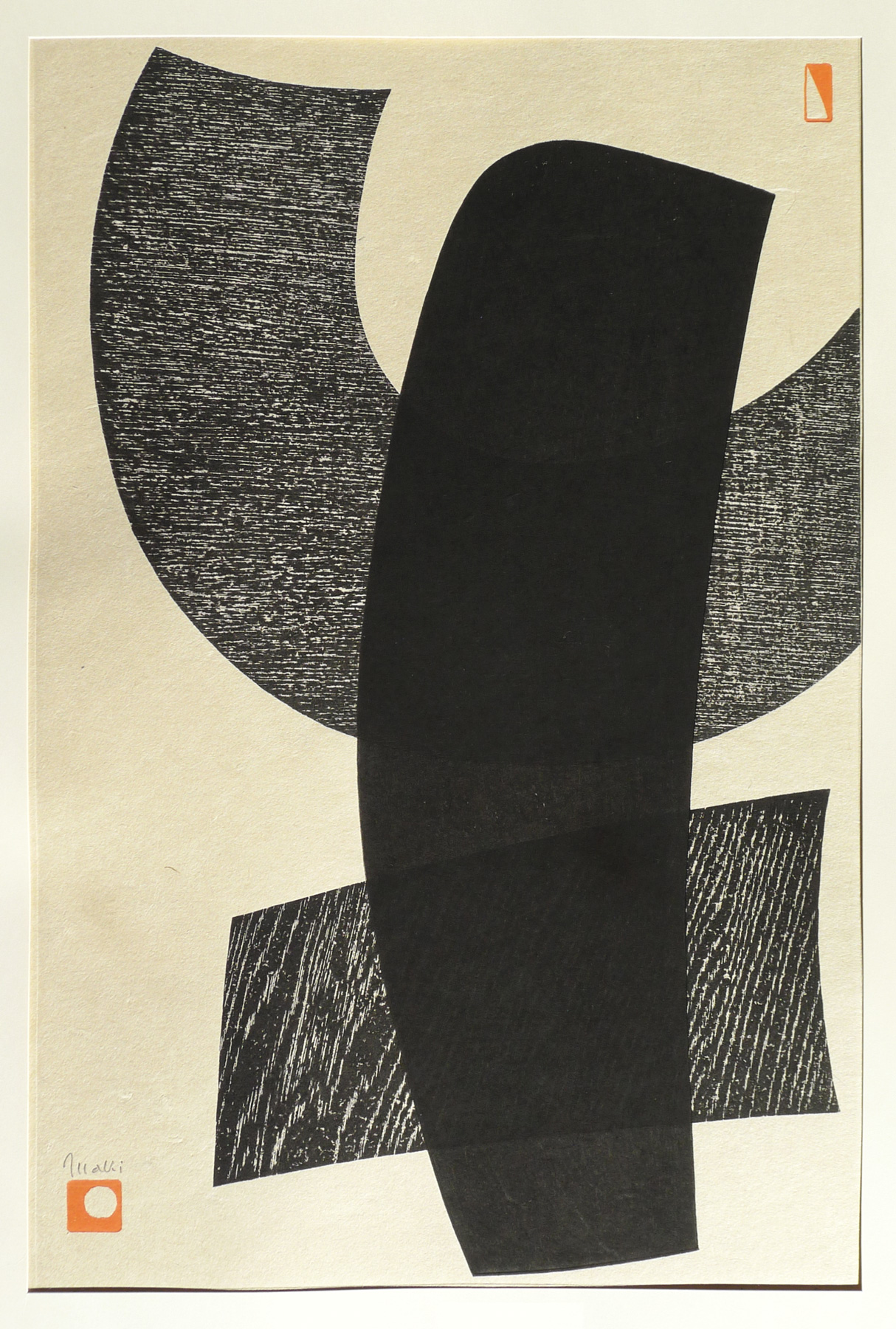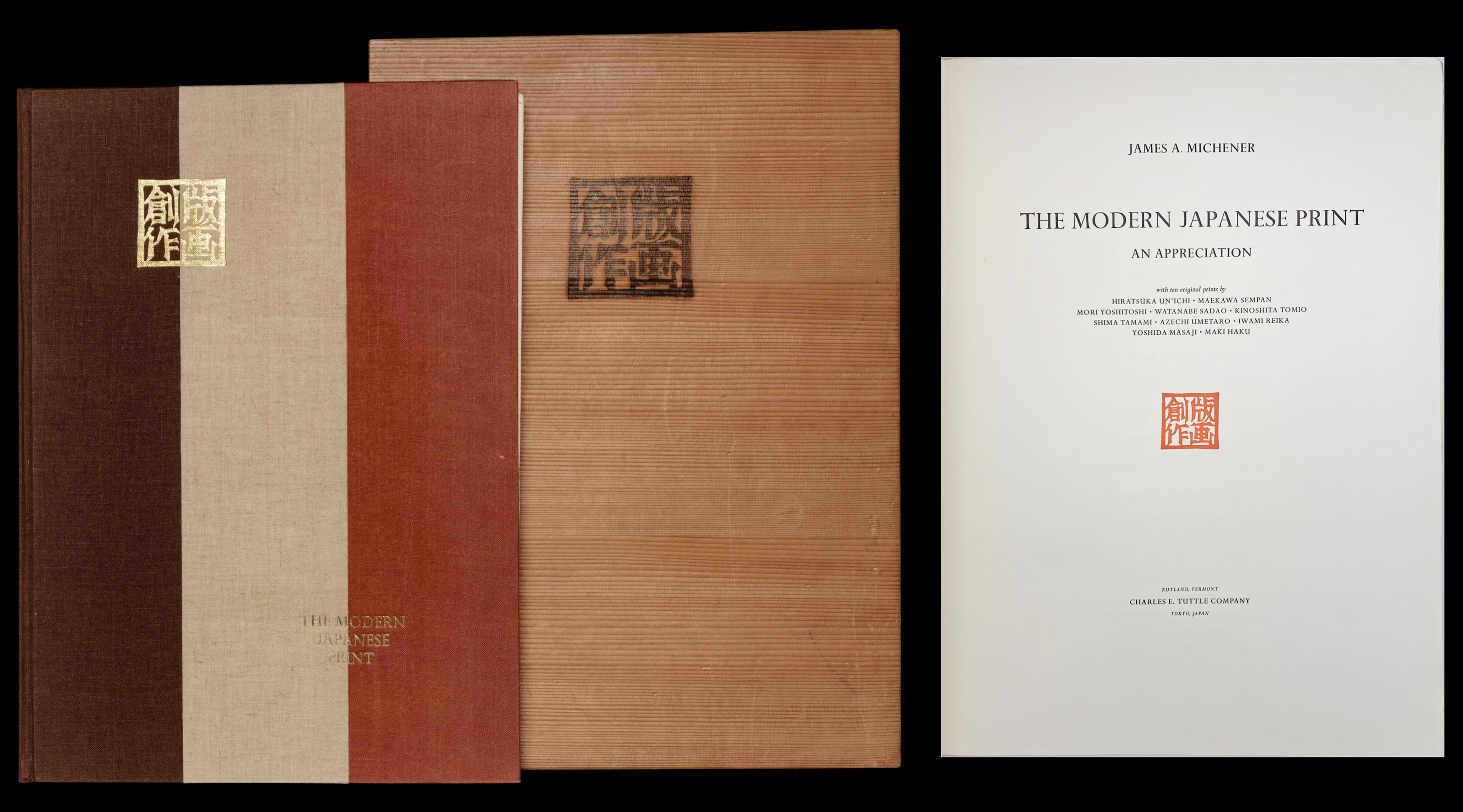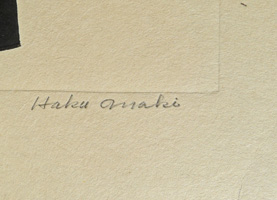About This Print
One of ten modern prints by ten different artists chosen for James Michener’s 1962 seminal work and portfolio of prints The Modern Japanese Print: An Appreciation, a work that brought Maki and the other artists to international attention.
"The Modern Japanese Print: An Appreciation" by James Michener
Note: Each print is tipped into Michener's book and placed under a mat that covers its margin, hiding the artist's signature, the print's title and the edition number on most of the prints.
In his introduction to this print, Michener write in part:
This calligraphic design by Maki is for several reasons an appropriate capstone to this book. For one thing, it demonstrates rather clearly the manner in which the younger artists are adapting the oldest techniques to their particular needs. [Maki]. . . gains much force by utilizing three different qualities of black: the traditional solid black in the upright stroke; a medium-force black in the lower horizontal stroke; and a handsomely mottled semi-gray black in the upper curved stroke. This wide contrast yields a most pleasing effect, and the eye is constantly lured from one of the variations to the other. A second deviation from old patterns is Maki's skillful use of three different textures of wood: the traditional solid, unblemished printing of the upright; the striking vertical graining of the lower horizontal; and the pleasing delicate mottling of the upper curve. Again, these textures carry the eye from one part of the design to the next, and when the variation in texture is wedded to the basic variation in the value of the black, a constant movement of symbol is attained, a kind of stately minuet of black and texture as forst one shape and the next takes command of the eye. Study the print for some minutes and watch this persuasive dance begin.
The third innovation is, of course, the most important. This concerns Maki's skilled use of the calligraphic symbol as the subject matter of art. In the contest several artists submitted prints constructed from calligraphic designs: some were marvelous free-flowing constructions in which the ideographs which Japan originally borrowed from China stood out conspicuously; others were bold utilizations of ideographic elements but without quite forming specific ideographs that could be identified; still others were abstractions which contained the merest suggestion of a calligraphic base.
The decision was finally made in favor of the present Maki. . . because its symbol was clearly derived from calligraphy yet so subtly modified as to free it from an obvious bondage. Furthermore, the symbol was used in such a controlled manner, both in coloring-texture and in disposition, as to remind the viewer that this was a work of conscious art.1
This print is based upon the character 牛, meaning cow or ox. I have here tried to give our cultural heritage of such ideographs a modern feel, but in an Oriental style. This meant trying to capture the typically Japanese expression of the beauty of space, the sense of reverence for and persistent pursuit of boundless space, while at the same time taking advantage of the boundary provided by the beauty and life of the paper itself. The beauty of sumi, in it monochrome black, penetrates to the back of the paper and forbids decorative exaggeration or irrelevancies. This effect combines with a succinct and straightforward approach to create a space and an expression that, though intentionally compact, still have a quiet and gentle spread. The two small red seals are an integral part of the composition, providing color and a focal point and thus making the impersonality of the sumi's space deeper and wider and warmer.2
THE PRINT: Artist's title: "Ushi" (Ox). Four blocks (cherry, lauan, and sen) of both solid board and plywood. One block printed in gaufrage to define the outer limits of the print with its embossed line, and the others printed in sumi ink and black Japanese-style pigment, on natural-color kozo paper. One impression for the gaufrage block and two impressions each for the black blocks.3
| IHL Catalog | #1336h | ||
| Title |  Ox (Ushi 牛) Ox (Ushi 牛) | ||
| Artist | Maki Haku (1924-2000) | ||
| Signature |
| ||
| Seal | Maki used two artist seals on this print. In the lower left image area he placed the above red square seal and in the upper right of the image he printed the below rectangular seal.  | ||
| Publication Date | 1962 | ||
| Edition | 463/510 | ||
| Publisher | Charles E. Tuttle Company, Tokyo | ||
| Carver | self-carved | ||
| Printer | self-printed | ||
| Impression | excellent | ||
| Colors | excellent | ||
| Condition | excellent | ||
| Genre | sosaku-hanga (creative print) | ||
| Miscellaneous | |||
| Format | dai-ōban | ||
| H x W Paper | 18 7/8 x 12 5/8 in. (47.9 x 32.1 cm) | ||
| H x W Image | 17 x 11 1/16 in. (43.2 x 28.1 cm) area within the rectangular "plate" line. 16 5/8 x 10 3/8 in. (42.2 x 26.4 cm ) image area | ||
| Collections This Print | Portland Art Museum, Portland, Oregon 2004.39j; Brooklyn Museum 63.15.10; Philadelphia Museum of Art 1964-201-1(10); Birmingham Museum of Art, Alabama 1990.93.10; The British Museum 1981,0205,0.1.10; Weatherspoon Art Museum, The University of North Carolina 1981.2837.10; Museum of Fine Arts, Boston 63.463 | ||
| Reference Literature | The Modern Japanese Print: An Appreciation, James A. Michener, [with Ten Original Prints by Hiratsuka Un'Ichi, Maekawa Sempan, Mori Yoshitoshi, Watanabe Sadao, Kinoshita Tomio, Shima Tamami, Azechi Umetaro, Iwami Reika, Yoshida Masaji, Maki Haku], Rutland, Charles E. Tuttle Company, 1962; The Modern Japanese Print - An Appreciation, James Michener, Charles E. Tuttle Co., 1968 [the "popular edition"] |





